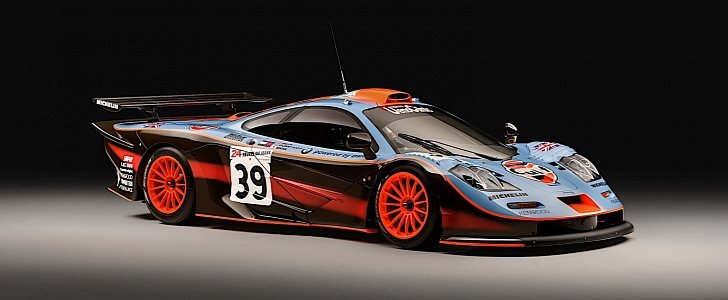The racing variant of the McLaren F1 was introduced in 1995 to take part in grand touring racing like the FIA GT Championship or the BPR Global GT. It did more than just take part, winning in the same year, despite all odds, the 24 Hours of Le Mans.
The final race chassis of the F1 GTR was retired in 2005, but that doesn’t mean the car is dead. On Friday, the British auto builder announced the birth of the certification service that would see McLaren F1 supercars authenticated by the company, restored and brought back to life.
To celebrate the announcement, McLaren pulled the wraps off the F1 GTR 25R, a fully restored tribute to the racing car of old. The car pictured in the attached gallery is the 1997 F1 GTR Longtail and is on display at the Hampton Court Concours of Elegance until September 2nd.
Originally built for the Gulf-Davidoff team to compete in GT racing, the restored car failed to bring back the title at LeMans in 1997, despite the best efforts of drivers Ray Bellm, Andrew Gilbert-Scott and Masanori Sekiya.
Chassis no. 25, as the car is known, was forced out two hours from the end of the race when an oil line fractured, causing a fire. It was later bought by Hitotsuyama Racing team in 1999 for which it raced in various competitions until 2005. It was the last F1 GTR ever to compete in a contemporary race series.
The restored model uses entirely parts manufactured before June 1997, and it even wears the Gulf-Davidoff team livery. The only non-McLaren parts in the entire car are the blue roof identification lights, taken from an aircraft’s wing, and used on the car at LeMans 21 years ago.
’25R’ presented us with a unique opportunity to demonstrate this by restoring it to precisely how it was when it raced at Le Mans in 1997, thus ensuring its future,” said in a statement Mike Flewitt, McLaren CEO.
“Maintaining the integrity of these historically significant cars is paramount, and F1 Certified will play a big role in allowing us to do that for the peace of mind of owners today as well as preserving a wonderful heritage for future generations of car lovers.”
To celebrate the announcement, McLaren pulled the wraps off the F1 GTR 25R, a fully restored tribute to the racing car of old. The car pictured in the attached gallery is the 1997 F1 GTR Longtail and is on display at the Hampton Court Concours of Elegance until September 2nd.
Originally built for the Gulf-Davidoff team to compete in GT racing, the restored car failed to bring back the title at LeMans in 1997, despite the best efforts of drivers Ray Bellm, Andrew Gilbert-Scott and Masanori Sekiya.
Chassis no. 25, as the car is known, was forced out two hours from the end of the race when an oil line fractured, causing a fire. It was later bought by Hitotsuyama Racing team in 1999 for which it raced in various competitions until 2005. It was the last F1 GTR ever to compete in a contemporary race series.
The restored model uses entirely parts manufactured before June 1997, and it even wears the Gulf-Davidoff team livery. The only non-McLaren parts in the entire car are the blue roof identification lights, taken from an aircraft’s wing, and used on the car at LeMans 21 years ago.
’25R’ presented us with a unique opportunity to demonstrate this by restoring it to precisely how it was when it raced at Le Mans in 1997, thus ensuring its future,” said in a statement Mike Flewitt, McLaren CEO.
“Maintaining the integrity of these historically significant cars is paramount, and F1 Certified will play a big role in allowing us to do that for the peace of mind of owners today as well as preserving a wonderful heritage for future generations of car lovers.”













